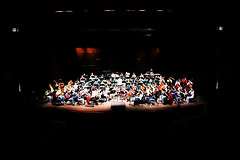|
Back
The Sound and Spirit of Heartbreak and Triumph Cincinnati
CCM – Corbett Auditorium
03/11/2011 -
Gustav Mahler: Symphony No. 6 in A Minor (“Tragic”)
CCM Philharmonia Orchestra, Mark Gibson (music director and conductor), Chia-Hsuan Lin (guest student conductor) 
(Courtesy of CCM Philharmonia Orchestra)
Mahler once wrote to a friend, “...my 'Sixth' presents a puzzle that will only be solved by those who have heard and understood what my first five are all about.” What the “tragedy” of Gustav Mahler's so-called “Tragic” Symphony may be remains a mystery. The work was composed during the blissful years following his marriage to Alma Schindler in 1902. Frau Mahler's letters, one quoting Mahler on the subject of the Scherzo's changing time signatures as "...games of their two little children, tottering in zigzags over the sand..." don't provide many clues. At the time, one of their children was a babe-in-arms and the second had not been born. Another letter of Alma's quotes Mahler speaking of “three mighty blows of fate” in the fourth movement. Yet any of these “blows of fate” – the departure from Vienna, the death of his two children, his heart condition – were yet to occur in 1902. Mahler flatly rejected meanings imposed on his compositions, preferring for them to “speak” through their music alone, while his “program music” exists in the text-driven pieces: Das Lied von der Erde, Lieder eines fahrendes Gesellen, Kindertotenlieder.
After a serene, limpid and elegant reading of the Overture to Mozart's La Clemenza di Tito, conducted by student Chia-Hsuan Lin, Maestro Mark Gibson took on the Everestian Mahler score, digging into its frenzied, craggy and zigzagging landscape with gusto, courage and temperament. The order of the “Tragic” Symphony's four movements here was that of the 2010 edition, and the work's massive orchestration – 20 woodwinds, 20 brass, 70 strings, celesta, two harps, two timpanis and a sizeable percussion section – was faithfully assembled. This imposing orchestral force achieved an overwhelming sonority on Friday night, with Maestro Gibson whipping his CCM Philharmonia into startingly brilliant playing, while also mining the work for its lyricism, notably in the third movement's Andante. The student players had their work cut out for them, with the brass and percussion sections never seeming to get “down time” thoughout the work's four movements. Special kudos to oboist Alexander Pons, bass trombonist Mark Kleine, tuba player Yukitada Onitsuka and to the rest of the brass section for some phenomenal work, including the mocking guffaws in the Scherzo that still ring in our ears.
Quiet lyricism is not the prevailing mood in Mahler's Sixth, though energy, forward drive, angst, bravura and flash are. Bravi to the CCM Philharmonia for delivering all those qualities by spades. Bravo to Mark Gibson for impassioned, humanistic music-making. Students whose average age may be in their early 20's miraculously managed to mine the sound and spirit of heartbreak and triumph that Mahler mastered in a lifetime of pain and joy and music-making. No small feat. This memorable concert was given once and it whets our appetite for more Mahler from Gibson and his students. When do we get the other nine symphonies?
Rafael de Acha
|